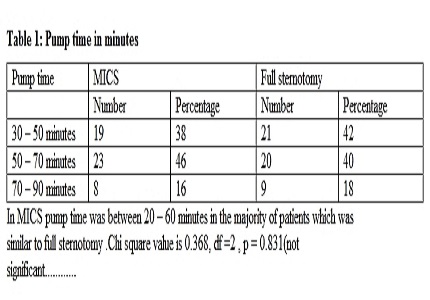Role of minimally invasive surgery in cardiac valve disease
Abstract
Introduction: Over the past decade minimally invasive cardiac surgery has gained significant popularity, more cases of valve, bypass and congenital surgery are being done by smaller incisions as experience increases.
Materials & Methods: Between January 2013 and December 2015 a total of 50 cases were performed using ministernotomy or right thoracotomy. The patients were between 17-58 years of age and included 29 males, 21 females.
Results: In Minimally invasive surgery average pump time was 20-60 minutes, cross clamp time 30-50 minutes, ventilation <8 hours, ICU stay < 1day, 2 or less units of blood required in majority of patients.
Conclusion: Minimally invasive cardiac surgery results in smaller incisions, shorter ventilator time, ICU and hospital stay, faster recovery, less pain, lower incidence of infection and bleeding and better cosmesis.
Downloads
References
Lancaster LL , Mavroudis C, Rees AH, Slater AD, Ganzel BL, Gray LA jr .Surgical approach to atrial septal defect in the female. Right thoracotomy versus sternotomy .Am Surg 1990; 56(4):218-221.
Rosengart TK, Stark JF. Repair of atrial septal defect through a right thoracotomy. Ann Thorac Surg. 1993 May;55(5):1138-40.
Cosgrove DM 3rd, Sabik JF. Minimally invasive approach for aortic valve operations. Ann Thorac Surg. 1996 Aug;62(2):596-7.
Krapf C, Wohlrab P, Häußinger S, Schachner T, Hangler H, Grimm M, Müller L, Bonatti J, Bonaros N. Remote access perfusion for minimally invasive cardiac surgery: to clamp or to inflate? Eur J Cardiothorac Surg. 2013 Nov;44(5):898-904. doi: https://doi.org/10.1093/ejcts/ezt070. Epub 2013 Feb 22.
Aranki SF, Rizzo RJ, Couper GS, Adams DH, Collins JJ Jr, Gildea JS, Kinchla NM, Cohn LH. Aortic valve replacement in the elderly. Effect of gender and coronary artery disease on operative mortality. Circulation. 1993 Nov;88(5 Pt 2):II17-23.
David TE, Armstrong S, Sun Z. Left ventricular function after mitral valve surgery. J Heart Valve Dis. 1995 Oct;4 Suppl 2:S175-80.
Cosgrove DM 3rd, Sabik JF, Navia JL. Minimally invasive valve operations. Ann Thorac Surg. 1998 Jun;65(6):1535-8; discussion 1538-9.
Mohr FW, Falk V, Diegeler A, Walther T, van Son JA, Autschbach R. Minimally invasive port-access mitral valve surgery. Minimally invasive port-access mitral valve surgery.



 OAI - Open Archives Initiative
OAI - Open Archives Initiative


